The Significant Difference
“I have often thought morality may perhaps consist solely in the courage of making a choice”
-Leon Blum
What does it mean to make wise choices? What does it mean to live your life by design? While your answers depend on what is most important to you, this much is certain: When you live your life by design, you know that you have a say over how it turns out. You act on that knowledge as if your life depends on it, and you experience the fulfillment that only purposeful attitudes, intentional behavior, and meaningful experience provide.
Yet you are faced with two difficulties at the outset. First, massive amounts of information and tremendous opportunities are pouring into your life through more channels than ever. Sorting through the noise for meaningful signals is a huge challenge. Some kind of filter is needed to weed out the extraneous and help you focus on ideas and information of greatest importance to you. Second, life in a rapidly changing world is filled with numerous variables outside of your control, and there is always the chance that you’ll be faced with an undesirable circumstance. When life deals you a weak hand, regardless of your opinions about it, you still have to play the hand you were dealt.
These two challenges force you to contend with a basic question: How is it possible to design your life amidst so much information, uncertainty and change? We believe that a life by design begins with the recognition that there is a significant difference between what is and is not your choice.
This book is an inevitable extension of our backgrounds and training as licensed naturopathic physicians. A naturopathic doctor (N.D.)1 attends a four year post-graduate medical school following standard premedical education, and receives the same basic science, clinical and diagnostic training as an M.D. . The significant difference between an M.D. and an N.D. is that naturopathic physicians focus on treating the whole patient, preventing illness and restoring health rather than merely treating the symptoms of illness with drugs and the removal of troublesome body parts. In other words, an N.D. looks at the whole person rather than this symptom or that organ. While this idea is just beginning to catch on in the conventional medical community, it the at the core of naturopathic medicine. This was brought home clearly to us in our very first class in naturopathic medical school.
This Doctor Comes In...
“The art of medicine consists of amusing the patient while nature cures the disease.” -Voltaire
Our professor shuffled into the classroom and took his place in the front of the room. He had a rumpled, intellectual quality to him, as he stood there in his tweed jacket waiting for the excited new students to quiet down.
"We are going to begin your education with a two step natural treatment for body lice that works great on small children. Step one: Drench the child in 100 proof pure, natural alcohol. Step two: Roll the child in pure, natural sand.”
He stood there silently a moment, his eyes scanning ours as we stared at him with questioning looks.
" The theory behind this treatment is that the lice will get drunk, throw rocks at each other and fall off."
Most of the students got the joke and laughed. Many of us relaxed. Some thought that perhaps they had been mistaken in their choice of careers, and tried to remember where they had parked their cars. But we’ll never forget what he did next.
The Two Kinds of Dis-ease
“There's nothing wrong with you that an expensive operation can't prolong.” — Graham Chapman
He drew two stick figures on the board.
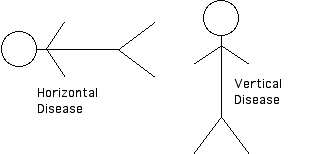
There are two kinds of dis-ease in this world, horizontal and vertical. Horizontal disease is any condition or illness that lays you out flat, that forces you to stop your normal activity and change your behavior. Horizontal disease can be anything from a bad flu to such life threatening conditions as stroke and heart attack. One positive aspect of horizontal disease is that it gets your attention. If you have any sense at all, horizontal disease motivates you to take some kind of action to deal with it and hopefully recover from it.
Vertical disease can actually be worse than horizontal disease, because a person can adapt to vertical disease and continue to function in society while the quality of life is slowly destroyed. Vague complaints are often a sign of vertical disease, like when a patient knows that something is wrong, but lab tests come back as borderline ‘normal.’
The chronic degenerative illnesses that plague modern society, like arthritis, cancer and hypertension, also fall into this category, as does the generally slow loss of function that people equate with aging. Most disease is vertical before it becomes horizontal.
No matter how much vertical disease a person is experiencing, the effects caused by it can be ameliorated if the person makes wise choices about what they take in, what they put out, and what they surround themselves with. Yet many people have trouble with this, because they either (1) don’t know that they have a choice, (2) don’t care that they have a choice, or (3) don’t have the support they think they need to make the choices that lead to the changes they desire. So the default choice for the vertically ill is to accept their ‘fate’ as the walking wounded . Our essential therapeutic goal is to help patients learn to make wise choices in order to optimize their health and maximize their chance for a high quality of life.
People do have choices, choices have consequences, and the sum total of those consequences equals the quality of life, health and well being a person experiences .
The Triangle of Choices
“Lord grant me the courage to change the things I can, the serenity to accept the things I cannot change, and the wisdom to know the difference.” -St. Francis’s prayer
To optimize the quality of your life, consider the Triangle of Choices.
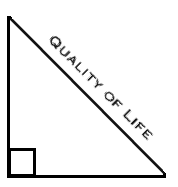
We begin with a simple right triangle. The hypotenuse of the triangle represents the quality of your life. The longer that line, the higher the quality of life that you experience. How do you make the hypotenuse of this triangle longer? You increase the length of either of the other two sides.
The base of the triangle is fixed at birth. It represents your constitution, your genetic inheritance, or the hand you’ve been dealt in the game of life.
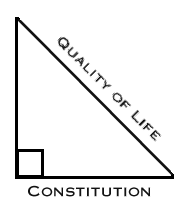
We all have our genetic strengths and weaknesses. Eyesight is an obvious example, but this is also true of hearts, kidneys, hormone levels and immune system response. And your constitutional strength isn’t just a physical phenomenon. If you have more than one child, or grew up with at least one brother or sister, you have probably observed that different children come into the world with different psyches, talents, needs and demands. You can even see this difference during the birth process. Some babies come out shouting "Here I am!” and others come out with a meek "Is this the right address?” In fact, some people are born with so much physical and psychological strength that life barely makes a dent in them. George Burns was certainly an example of constitutional strength. He lived to be 100 years old, and right up to the end of his life he was active , he was alert ...and he smoked 18 cigars a day. When he was asked, "What do your doctors say about that?" He replied, "They say nothing. They’re all dead."
Such constitutional fortitude is the reason why some people don’t have to put much attention into how they take care of themselves. They can smoke, drink and lose sleep and it doesn’t seem to matter, they seem to have remarkable stamina that allows them to stay healthy. That’s also why some people have to put an incredible amount of time, energy and money into how they take care of themselves. They must watch what they eat, what they drink, and make sure they get enough sleep, or they feel run down and vulnerable to getting sick. This accounts for the biochemical individuality that makes direct comparisons of your behavior to the behavior of others inaccurate, and reveals the value of recognizing your own individual needs. Your constitutional baseline is fixed and, while you can shorten this line through accidents and other damaging events, you cannot lengthen the base of your triangle.
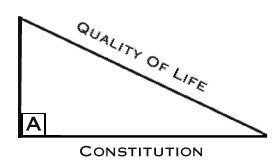
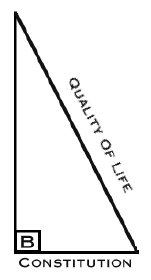
(caption) Both person A and person B represent the same degree of health, however person A doesn’t have to do much to maintain it , while person B has to work much harder at it.
However, your constitution isn’t just physical or psychological. Some people are born into fortunate circumstances, while others seem to have been born under a bad sign. The child of a prosperous family may gain certain advantages not available to the one born on the ‘wrong’ side of town, and the person born in a free society may have certain advantages over the person born into a minority race or religion in an oppressive society. And if you extrapolate the triangle of choice out to other systems, like families and businesses, then you see that each of these systems also starts out with a given hand consisting of foundational strengths and weaknesses over which members have little choice so long as they’re in that system. Most people don’t have much choice about who their parents are. You may not have a choice over the changes happening in the industry in which you work right now.
Regardless of what you want to achieve in life, there will likely be some factors that are beyond your choice. Like it or not, when it comes to the hand you’ve been dealt in life, you’ve got to play it. The good news is that there will always be factors about which you do have a choice, factors that you can change and factors that you can influence. These choice factors are represented by the third line, the height of the triangle.
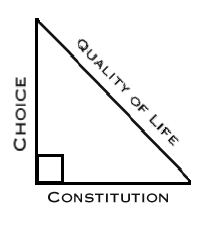
One choice factor is nourishment. In the late 1980’s, then-surgeon general Everett C. Koop found that the U.S. was spending 28% of the entire health care budget on nutritionally preventable disease. What you eat, when you eat, and how you eat will all effect your health and well being. Another choice factor relates to your activity level. While not all kinds of exercise are right for everyone, some kind of exercise is right for you. Numerous studies have shown that people who exercise regularly tend to have more physical and mental energy, and are less likely to experience depression than their sedentary counterparts. Environment, from the quality of the air you breath and the water you drink to whether you live in a noisy urban or sleepy rural setting, is another factor that can influence your health and well being.
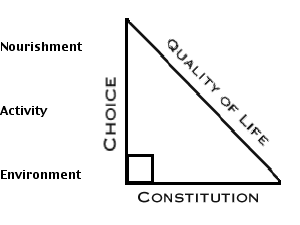 However there is more to you than food, exercise and environment. Your attitude towards life will also have an effect on your overall health and well being. For example, if you treasure life and see yourself as valuable, you’re more likely to nourish yourself than if you take life for granted and have low self esteem. If you have a sense of control over your life by clearly defining your values and goals, you are more likely to engage in activities that fulfill you. And if you surround yourself with people that care about you and support you, that atmosphere is more conducive to well being than one polluted by fear, negativity and disappointment. It is a simple equation: The more of these choice factors that you can optimize, the more happiness and fulfillment you will experience. The choices covered in this book are the result of our work with thousands of patients and hundreds of thousands of seminar participants. While our list is not all inclusive, it represents the key choices necessary to living a life by design.
However there is more to you than food, exercise and environment. Your attitude towards life will also have an effect on your overall health and well being. For example, if you treasure life and see yourself as valuable, you’re more likely to nourish yourself than if you take life for granted and have low self esteem. If you have a sense of control over your life by clearly defining your values and goals, you are more likely to engage in activities that fulfill you. And if you surround yourself with people that care about you and support you, that atmosphere is more conducive to well being than one polluted by fear, negativity and disappointment. It is a simple equation: The more of these choice factors that you can optimize, the more happiness and fulfillment you will experience. The choices covered in this book are the result of our work with thousands of patients and hundreds of thousands of seminar participants. While our list is not all inclusive, it represents the key choices necessary to living a life by design.
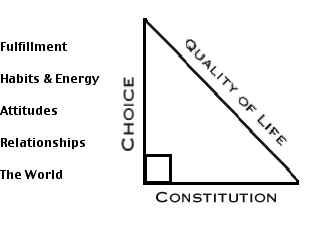
You can choose to optimize your quality of life by paying attention to the choice factors, and focusing on what can be done and doing it. Or you can choose to focus on what can’t be done, and focus on the circumstances over which you have no control. That choice is always yours.
Now Is The Time To Choose
“When you come to a fork in the road, take it.” -Yogi Berra
To live a life by design, you must first acknowledge that there will always be variables over which you have no choice, and variables over which you always have a choice. You can choose to experience your life as having a purpose that you are able to fulfill. You can choose to make wise choices about which habits to develop and which to eliminate. You can choose attitudes that empower you meet your challenges head on. And you can choose to make the connections that help you and support you in living a life of meaning instead of regret.
To get the most out of this book, we recommend that you start with Chapter One and work your way to the end. Along the way, each chapter has an area called ‘Inventory Your Experience’ that contains activities for gaining leverage from each chapter. If you do the activity and then progress to the next chapter, by the end of this book you’ll have a blueprint for living your life by design in this mixed-up world. Although this book is written to be read from cover to cover, we realize that one of the four sections may have more immediate value for you than the others. For example, if you already have a high degree of clarity about what would fulfill you in life but you have difficulty creating supportive relationships, you may want to turn immediately to the ‘Making The Connections’ section of the book . Whether you read the book in order, or skip around according to what most interests you, we’ve designed the table of contents to be a quick read through, and review, of the wise choices described in each chapter.
How you read this book is your choice, and we hope you enjoy making it. Ready? Let’s get started!
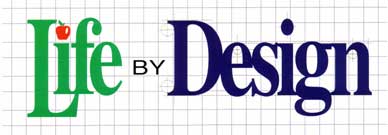






 However there is more to you than food, exercise and environment. Your attitude towards life will also have an effect on your overall health and well being. For example, if you treasure life and see yourself as valuable, you’re more likely to nourish yourself than if you take life for granted and have low self esteem. If you have a sense of control over your life by clearly defining your values and goals, you are more likely to engage in activities that fulfill you. And if you surround yourself with people that care about you and support you, that atmosphere is more conducive to well being than one polluted by fear, negativity and disappointment. It is a simple equation: The more of these choice factors that you can optimize, the more happiness and fulfillment you will experience. The choices covered in this book are the result of our work with thousands of patients and hundreds of thousands of seminar participants. While our list is not all inclusive, it represents the key choices necessary to living a life by design.
However there is more to you than food, exercise and environment. Your attitude towards life will also have an effect on your overall health and well being. For example, if you treasure life and see yourself as valuable, you’re more likely to nourish yourself than if you take life for granted and have low self esteem. If you have a sense of control over your life by clearly defining your values and goals, you are more likely to engage in activities that fulfill you. And if you surround yourself with people that care about you and support you, that atmosphere is more conducive to well being than one polluted by fear, negativity and disappointment. It is a simple equation: The more of these choice factors that you can optimize, the more happiness and fulfillment you will experience. The choices covered in this book are the result of our work with thousands of patients and hundreds of thousands of seminar participants. While our list is not all inclusive, it represents the key choices necessary to living a life by design.